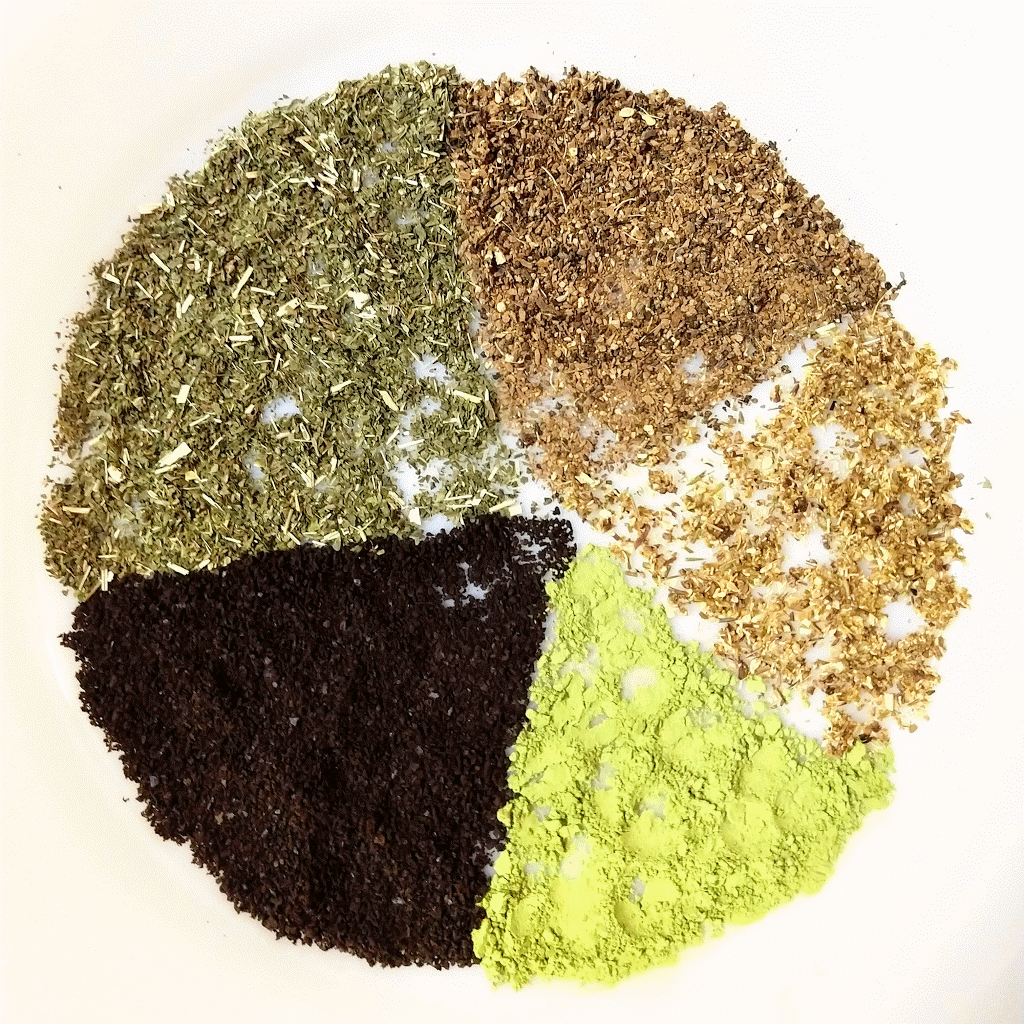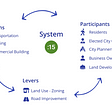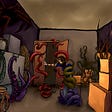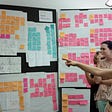AUTOmeetic — An Incentive System for Coworking Spaces to Reduce Carbon Emissions
AUTOmeetic is the design solution of a ten-week group project for the Design Thinking Studio at Global Innovation Exchange (GIX). As a team of 3, we went through stages of the design process, including scoping the design question, investigating, generating requirements, ideating, prototyping, evaluating, and iterating feasible solutions.
The Design Prompt: A Low-Carbon Vision of Hybrid Work
Hybrid work has become a post-pandemic trend and a priority for employees. It is the new normal but does not directly translate to low carbon emissions without additional action.
If the company does nothing, employees may overuse air-conditioning and energy-consuming equipment. Meanwhile, employees working remotely also emit greenhouse gasses in their workspaces.
As a result, the carbon footprint of a hybrid work could be close to or even higher than that of a full-time office working model, according to estimates from the Financial Times.
The Design Question
How can hybrid workers in the urban and suburban areas of the United States coordinate schedules in an open workspace to limit energy usage at work?
Alright, let’s go to the field and learn from people
1. Field Observation
The reason for doing field observation is that it can produce very detailed data. It ensures that we have as unbiased a record as possible, from which we can uncover insights and reveal social facts that are not immediately obvious.
In our secondary research, we found that open office environments can be used flexibly to meet the needs of a changing workplace. For this reason, we conducted field observations at WeWork in Bellevue, Washington, to understand how employees behave in such an environment.
2. Survey
Conducting surveys allows us to include a broader population and make statistics to answer questions we want to understand further after field observations.
We created a survey using Google Forms to get perspectives and feedback from hybrid workers directly. Our survey focused on learning more about a few takeaways from our focal points. In particular:
- Is air conditioning centrally managed for other work environments as well?
- How many workers commute to the office to meet in group environments, like conference rooms?
- How often are open work environments and team meeting areas utilized?
- What are the primary motivations for people to commute to the office?
- What do workers want more of in the office?
- What resources are most used for teamwork?
- What resources are most desirable for individual, focused work?
So, what findings do we have? any insight?
1. Finding: Some resources in the office are overused, such as unused lights, HVAC, and laptops that are still running when employees leave to perform another task (e.g., group meetings).
- 🪄 How might we create an app that can operate smoothly so that employees can effortlessly maximize the planned use of office space and avoid partial use?
2. Finding: For hybrid workers, driving employees to leave their homes and desire to go to the office are, in this order: (1) free food, snacks, and beverages; (2) access to tools and equipment; and (3) personal private offices.
- 🪄 How might we design food/drink incentives so that employees are motivated to free up unused spaces and turn off their HVAC and lights?
3. Insight: The current workspace design usually does not empathize with employees’ needs for privacy and a sense of security. These factors relate to their concentration and productivity at work.
- Most respondents identified a personal private office as their preferred place for focused personal work. However, more than 50% of respondents think that individual private offices are the most in short supply in their work environment.
- While many respondents identified open workspaces as their preferred place for teamwork and collaboration, many more pinpointed private conference rooms as the best option. However, more than 50% of respondents think private meeting rooms are the most scarce in their work offices.
- 🪄 How might we design a preview and book feature that allows employees to determine if their most desired workspace is available before leaving home and heading to it?
Introducing “AUTOmeetic”
The new AUTOmeetic is an integrated software and hardware design solution. It can be used alone in a shared workspace or embedded in an existing internal management system of an enterprise.
Step 1. The employee completes the room reservation through the app and scans the QR Code to enter the room.
Step 2. When leaving the room, the app notifies them whether to release the space to others.
Step 3. After choosing to release, the air conditioner and lights will be automatically turned off, and reward points will be issued to the employee’s app.
Step 4. With the reward points, they can redeem free snacks, coffee, or drinks via a kiosk.
So, how do users’ feedback on the use of AUTOmeetic?
Overall, users were very positive in their feedback about the overall app flow, the form of the kiosk, and the function of scanning QR codes in the app to check into meeting rooms and redeem points for rewards.
To our surprise, some participants would like to think beyond the tasks and make recommendations based on the whole system to provide some great suggestions.
For example, one participant asked why people wanted bonus points and whether they needed them. In our proposal, office workers can use bonus points to buy snacks. But the participants raised more possibilities like socializing activities and meetups, which could help us think differently about the essence of providing bonus points and make it more valuable.
Some other participants also raised the potential loopholes in the system and whether workers would exploit them. That also pushed us to think more about the reasonability of the design and what we could do to prevent users from impairing other people and the organization.
Regarding user-reported issues, five were flagged as “conflict of interest/motivation,” three were flagged as “confused,” and one each for “booking accuracy,” “missing options,” and “accessibility.”
This indicates:
- Our primary issue was that we did not clearly convey the rationale and goal of the solution or that participants were not sufficiently motivated by it.
- Second, app flows sometimes mislead or confuse users. This could compromise the effectiveness of the application in effectively utilizing the meeting room, thereby affecting the benefit of reducing carbon emissions.
- Lastly, most of the remaining feedback has less impact on users. However, the lack of some filtering options when booking reduces the ease of use, so adjustments are needed to make the selection of the number of attendees and time slots more intuitive.
So, what improvements did we make? And what about the future?
First, we identified issues that block normal operations for some users as the highest priority. These must be corrected immediately.
For example:
Regarding the second point mentioned in the previous paragraph (App flows sometimes mislead or confuse users), some users noted that the flow of booking a room lacks a confirmation, making them confused about whether they have completed the booking. Therefore, we considered it necessary to fix it quickly to avoid repeated operations due to confusion.
Regarding the third point mentioned in the previous paragraph (Lack of some filtering options when booking), we believed this would increase the time required for this process for users with different needs. Therefore, we decided to add filters such as scheduled date, the number of people, and needed equipment on the browsing page. With a slight adjustment, users can easily filter out suitable spaces without feeling visually overloaded with too many options.
🤔 Next steps (what can be done in the future):
We generated our top seven specific and actionable steps. We value some that are not necessarily the highest priority but ultimately benefit the most individuals by improving the usability for a smaller group of underrepresented people.
- Include a summary of existing meetings so users can easily track them.
- Add “conditional judgments” about usage time in the program to prevent users from quickly booking and releasing rooms to get points, protecting the organization from extra costs and supporting the primary goal of reducing carbon emissions.
- Add a “vivid and dynamic UI tutorial” to fully inform the ultimate goal of energy saving with an easy-to-find in-app icon (such as “?”).
- Include instructions in the mobile app when users are intended to present a QR code to a physical scanner at a meeting room or the reward kiosk.
- Add quick booking options for users based on historical usage.
- Add a banner to the start screen of the rewards kiosk to advertise rewards to encourage adoption.
- Relocate the QR scanner on the reward kiosk from the right side to the front to make it as universally accessible as possible, so left-handed users, users with disabilities, and encumbered users (e.g., those carrying things when using the machine) can effortlessly redeem rewards.
Reflection: What did I learn through Design Thinking Studio? What are the key takeaways that will help improve in the future?
1. About scoping the design question:
- Defining valid questions is helpful for subsequent research.
- Instead of jumping to a solution, prepare and understand by performing background research, field observations, surveys, prototypes, and usability tests.
- Consensus on a design question is crucial to success. This includes transparency of facts and processes necessary for collaboration.
2. About collecting and processing data:
- As a researcher, we should conduct field observations with an open mind. Reality might defy expectations.
- It is challenging but worthwhile to get raw data from potential users/consumers since it can differ from our research or provide more information.
3. About conducting a survey and user testing:
- Providing some incentives can increase the response to the survey and make participants more motivated in the usability testing.
4. About mindsets of doing UX research (and can be extended to business and even lifestyles):
- Patience — There is no shortcut to success! People typically dislike doing repetitive things and are cautious, but the research process allows people to make the right choice.
- Making the right design decisions is a far higher priority. Even if the journey is procrastinating, if we make the right design decisions, in the end, we can reap huge benefits and benefit others.
- With good design, impact and investment are balanced. Those big successful companies are likely more patient to spend or even waste the most time on this matter. The market is a device for transferring money from the impatient to the patient.
5. About team collaboration:
- Team members “take the initiative” to express mutual respect so that everyone is willing to share their ideas.
- Project collaboration tools are necessary to keep everyone on the same page — Figjam is our jam!
- Clear communication is essential for success. Don’t hesitate to ask when you don’t know the intentions of others.
- Listening to teammates and finding things in common is vital in a successful team.
My Team Members
The three of us had no official roles assigned. We worked together on all the design thinking processes except for the prototyping.
- The physical prototype: Designed and made by Darius Rose.
- The Figma (software) prototype: Co-created by Zhengyang Yang and Chia-Wei Chang (me).
🎉 Finally, thanks to everyone who read my article to the end :) Have a nice day!
For future business partners & recruiters:
- This PDF file records the whole process of how we did primary and secondary research, including stakeholder analysis, field study notes, affinity diagrams, surveys, etc.
- This PDF file records how we ideated feasible solutions using tools like creating scenarios, drawing sketches, and building storyboards.
- This PDF file records the whole process of prototyping and conducted user testing.
- Get In Touch: LinkedIn








